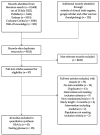Effect of Dietary Approaches on Glycemic Control in Patients with Type 2 Diabetes: A Systematic Review with Network Meta-Analysis of Randomized Trials
- PMID: 37513574
- PMCID: PMC10384204
- DOI: 10.3390/nu15143156
Effect of Dietary Approaches on Glycemic Control in Patients with Type 2 Diabetes: A Systematic Review with Network Meta-Analysis of Randomized Trials
Abstract
Background: Dietary patterns play a critical role in diabetes management, while the best dietary pattern for Type 2 diabetes (T2DM) patients is still unclear. The aim of this network meta-analysis was to compare the impacts of various dietary approaches on the glycemic control of T2DM patients.
Methods: Relevant studies were retrieved from PubMed, Embase, Web of Knowledge, Cochrane Central Register of Controlled Trials (CENTRAL), and other additional records (1949 to 31 July 2022). Eligible RCTs were those comparing different dietary approaches against each other or a control diet in individuals with T2DM for at least 6 months. We assessed the risk of bias of included studies with the Cochrane risk of bias tool and confidence of estimates with the Grading of Recommendations Assessment, Development, and Evaluation approach for network meta-analyses. In order to determine the pooled effect of each dietary approach relative to each other, we performed a network meta-analysis (NMA) for interventions for both HbA1c and fasting glucose, which enabled us to estimate the relative intervention effects by combing both direct and indirect trial evidence.
Results: Forty-two RCTs comprising 4809 patients with T2DM were included in the NMA, comparing 10 dietary approaches (low-carbohydrate, moderate-carbohydrate, ketogenic, low-fat, high-protein, Mediterranean, Vegetarian/Vegan, low glycemic index, recommended, and control diets). In total, 83.3% of the studies were at a lower risk of bias or had some concerns. Findings of the NMA revealed that the ketogenic, low-carbohydrate, and low-fat diets were significantly effective in reducing HbA1c (viz., -0.73 (-1.19, -0.28), -0.69 (-1.32, -0.06), and -1.82 (-2.93, -0.71)), while moderate-carbohydrate, low glycemic index, Mediterranean, high-protein, and low-fat diets were significantly effective in reducing fasting glucose (viz., -1.30 (-1.92, -0.67), -1.26 (-2.26, -0.27), -0.95 (-1.51, -0.38), -0.89 (-1.60, -0.18) and -0.75 (-1.24, -0.27)) compared to a control diet. The clustered ranking plot for combined outcomes indicated the ketogenic, Mediterranean, moderate-carbohydrate, and low glycemic index diets had promising effects for controlling HbA1c and fasting glucose. The univariate meta-regressions showed that the mean reductions of HbA1c and fasting glucose were only significantly related to the mean weight change of the subjects.
Conclusions: For glycemic control in T2DM patients, the ketogenic diet, Mediterranean diet, moderate-carbohydrate diet, and low glycemic index diet were effective options. Although this study found the ketogenic diet superior, further high-quality and long-term studies are needed to strengthen its credibility.
Keywords: Type 2 diabetes; dietary patterns; network meta-analysis.
Conflict of interest statement
The authors declare no conflict of interest.
Figures






References
-
- World Health Organization . Global Report on Diabetes. World Health Organization; Geneva, Switzerland: 2016.
-
- Saeedi P., Petersohn I., Salpea P., Malanda B., Karuranga S., Unwin N., Colagiuri S., Guariguata L., Motala A.A., Ogurtsova K. Global and regional diabetes prevalence estimates for 2019 and projections for 2030 and 2045: Results from the International Diabetes Federation Diabetes Atlas. Diabetes Res. Clin. Pract. 2019;157:107843. doi: 10.1016/j.diabres.2019.107843. - DOI - PubMed
-
- Pan X.R., Li G.W., Hu Y.H., Wang J.X., Yang W.Y., An Z.X., Hu Z.X., Lin J., Xiao J.Z., Cao H.B., et al. Effects of diet and exercise in preventing NIDDM in people with impaired glucose tolerance. The Da Qing IGT and Diabetes Study. Diabetes Care. 1997;20:537–544. doi: 10.2337/diacare.20.4.537. - DOI - PubMed
Publication types
MeSH terms
Substances
LinkOut - more resources
Full Text Sources
Medical

